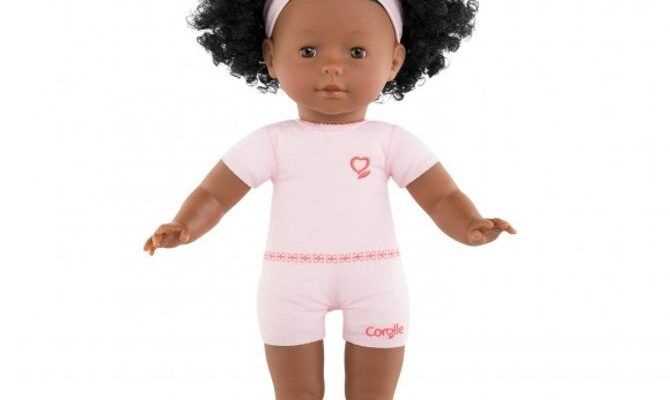Yes, it is still rare to find black dolls in the local supermarket where the lack of diversity remains omnipresent. To stop wasting time scouring the toy shops and online sales sites, we have prepared our selection of racialized dolls for you.
More than ever, it is important that children can identify with role models and feel represented, regardless of their skin color, ethnicity, religious or gender affiliation. The way they look at the world depends intrinsically on the environment in which they will learn and develop. Packaging that begins with the choice of toys because these are the first products that the youngest are confronted with. Unfortunately, we quickly realize the lack of diversity and inclusiveness in supermarkets, specialty toy stores and online.
Namely, the first black dolls appeared at the beginning of the 20th century bearing racist names like “Bamboula” or “Negri”. From the 60s, some brands like Corolle released their first “ethnic” baby or even Barbie with their first “black” girlfriend. Nowadays, it is still difficult to find racialized dolls, at the risk of stumbling upon black dolls with European features and straight hair.
Stereotypes embedded in the minds of children
In the 1950s, two African-American child psychiatrists, Kenneth and Mamie Clark, investigated the effect of racism on black children. To do this, they had chosen to offer two types of dolls to black girls and boys, by asking them different questions: “which is the prettiest? Who is the nicest? Which do you want to play with? What's the ugliest? Who is the meanest? And finally, who he / she looks the most like. "
At the end of this test, the children systematically assigned the positive qualities to the white doll and the set of defects to the black doll. Worse yet, they identify with the black doll with great reluctance. In the early 2000s, the experiment was tried again but the results remain the same.
The importance of representation
From an early age, children begin to build their own identity with tastes, choices, desires and a personality of their own. A decisive period in their lives as they begin to express themselves and develop their imagination and creativity. Children also try to understand the world of adults by reproducing what is happening around them using toys. So that they can develop without being confronted with a biased vision of reality, it is important to provide them with dolls of all colors so that they can have a global vision of the world in which they operate. This step therefore involves having a beautiful doll that looks like them, but also with inclusive characteristics such as the nature of hair, the representation of all body types, all nationalities, all cultures and all sexual affiliations. So having toys that represent racialized people will help all children learn and understand each other without seeing them differently.
A diversity that will allow your child to be more open to other people and to avoid living with stereotypes. On the show "I'm not a racist," researchers asked several white children to identify the positive qualities between drawings with two people of different colors. Consistently, children assimilated positive qualities to white people. According to researcher Christine Deruelle, from the Marseille Neurosciences Institute, this stereotypes reflects a phenomenon of social fear: “Children without exception refer to the white boy and one can identify racial stereotypes implicitly quite early in development at 3-4 years. There is already evidence of different attributions according to their own ethnicity with an attribution of positive values to their own ethnicity and negative values to the ethnicity of which they are not part. "
Faced with this alarming finding and in order to change things, it is therefore important to bring diversity to your child so that he can flourish while being aware of the world around him.
Here is our selection of racialized dolls:
- Pauline curly hair doll – Corolle – from 40 euros
- Ndanaka doll – Sibahle Collection – from 44.90 euros
- Kymia Waxpoisson – Urbidolls – from 47.00 euros
- Black rag doll – Etsy – from 26.34 euros
- Classic Doll 46cm – Haven Our Generation – Babygloo – from 37.90 euros
- Classic Princess Tiana doll – est & gclid = EAIaIQobChMIlML81_OG6wIVh7PtCh1CsQDaEAQYHCABEgIUN_D_BwE "rel =" noopener noreferrer no nofollow "target =" _ blank "> Disney Store – from 16.90 euros
- First bath doll with headband – Oxybul – from 34.99 euros
- Black Rag Doll Ballerina – Etsy – from 28.74 euros
- African-American doll 35 cm – Fnac – from 27.92 euros
- Fabric doll – Kaloo – from 24.99 euros
- Indian doll – Etsy – from 30.76 euros
- Handmade doll with traditional clothes – Etsy – from 57.15 euros
- Handmade Asian Rag Doll – Etsy – from $ 21.98
- Vintage Indian doll – Etsy – from 26.38 euros
- Asian porcelain doll – Etsy – from 27.82 euros
- Asian doll – Miniland – from 44.00 euros
- Asian child doll 38cm – Miniland – from 40.49 euros
- Traditional Chinese doll – La chineuse – from 19.90 euros
- 3 Japanese Kokeshis dolls – La chineuse – from 19.00 euros
- Flora doll – Babygloo – from 50.90 euros
- Classic Seraya Doll 15cm – Babygloo – from 14.90 euros
- 46 cm doll with her dog Malia – Babygloo – from 53.90 euros
- Deluxe 46cm doll – Babygloo – from 58.90 euros
